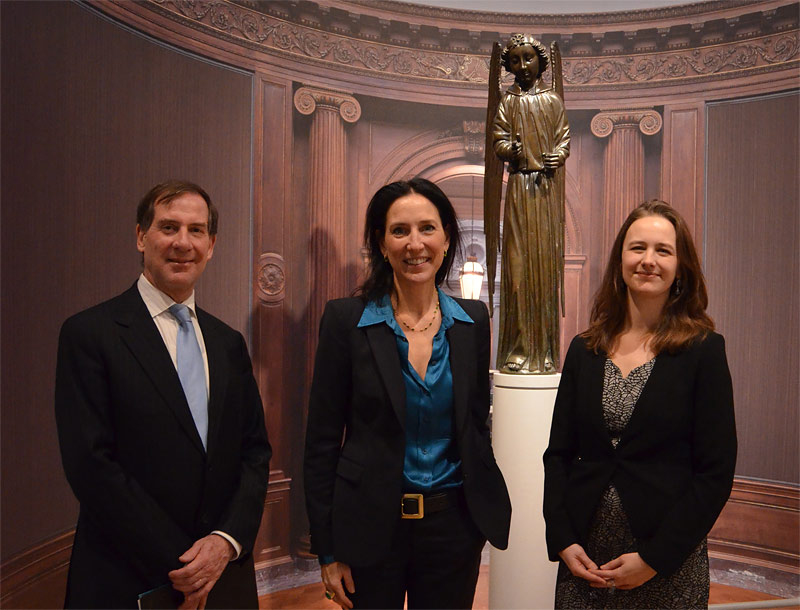Ingres, Cimabue, Memling, Tiepolo, Goya, Van Eyck, Constable. Louter topnamen uit de kunstgeschiedenis en van vele hangt nauwelijks werk in Nederlandse musea. Maar nu even wel. Het Mauritshuis in Den Haag toont vanaf 5 februari maar liefst 36 werken uit de beroemde Frick Collection in New York. En dat museum leende nooit eerder zoveel kunstschatten uit.
Daarom heeft het Mauritshuis drie bijzondere primeurs.
1. The Frick Collection leent normaal niet uit
The Frick Collection is een van de belangrijkste verzamelingen van Europese kunst in de Verenigde Staten. Grondlegger Henry Clay Frick (1849-1929) werd rijk in de staal- en cokesindustrie. Het was de ‘Gilded Age’, het ‘vergulde’ tijdperk waarin industrieel geld zorgde voor een opleving in de kunsthandel. Frick verzamelde op eigenzinnige manier kunst uit Europa en liet een neoclassicistisch huis bouwen dat na zijn dood als museum dienst moest doen. Bij zijn overlijden liet hij zijn landgenoten een indrukwekkende collectie na, waaruit volgens zijn testament niets uitgeleend mocht worden.
Dat het Mauritshuis er toch in slaagt werk uit deze Frick Collection te tonen, is te danken aan de voorgeschiedenis. In het najaar van 2013 hingen 15 topstukken uit het Mauritshuis in the Frick Collection. Onder andere het Meisje met de Parel van Vermeer en het Puttertje van Fabritius deden New York aan op tournee tijdens de verbouwing van het Mauritshuis. In die drie maanden trok the Frick Collection meer bezoekers dan normaal in een jaar. Daar wilde het museum graag iets tegenoverstellen.
Directeur Emilie Gordenker van het Mauritshuis moet bekennen dat ze een moment heeft geaarzeld toen ze het aanbod kreeg. Er mochten immers alleen werken worden uitgeleend die buiten het testament van Frick vielen. Gelukkig bleef er genoeg interessants over. Deels doordat zo’n 30 % van de collectie na de dood van Frick is aangekocht, deels doordat een aantal van zijn eigen aankopen buiten het legaat vielen en later alsnog door de familie aan het museum geschonken zijn. Voor deze werken geldt de beperking niet.
2. Deze kunstenaars zijn zelden in Nederland te zien
Wat er nu in het Mauritshuis hangt en staat, is van een verbluffende kwaliteit én diversiteit. Behalve schilderijen zijn er puntgave tekeningen te zien van Goya tot Rubens, toegepaste kunstvoorwerpen, zoals een zeldzame tafelklok, en sculpturen, waaronder Francesco Laurana’s ontroerend moderne buste van Beatrice van Aragon, die stamt uit het eind van de 15e eeuw.
Ian Wardropper, directeur van the Frick Collection, is blij met die brede selectie van Gordenker en conservator Lea van der Vinde. ‘We bouwen een huis,’zegt hij, ‘niet alleen een collectie.’ Net als het Mauritshuis is the Frick Collection immers gevestigd in een voormalig woonhuis, met een relatief kleine, maar zeer hoogwaardige collectie. ‘Size isn’t everything,’ zegt Gordenker gekscherend.
Ook qua periode is de tentoonstelling zeer veelomvattend. Normaal toont het Mauritshuis vooral schilderijen uit de 16e, 17e en 18e eeuw. In deze tentoonstelling hangt en staat werk vanaf de 13e eeuw (De geseling van Christus van Cimabue) tot en met 19e eeuw (Portret van de Comtesse d’Haussonville van Ingres). Dat laatste portret is zo’n beetje ‘het Meisje met de Parel van de Frick’ en siert het affiche. Van veel kunstenaars, zoals Cimabue, Van Eyck, Gainsborough en Constable is normaal geen of zeer weinig werk in Nederland te zien. Van Ingres zelfs helemaal niets.

3. De nieuwe vleugel van het Mauritshuis is nu echt in bedrijf
Voor het Mauritshuis is er ook nog een andere primeur: het is de eerste kunstexpo in de nieuwe Royal Dutch Shell Vleugel. In de zomer 2014 heropende het museum na een grote verbouwing en uitbreiding. In de nieuwe vleugel, in een art deco-pand aan het Plein, zag de bezoeker toen een overzicht van de geschiedenis van het gebouw. Voor de eerste kunsttentoonstelling deelde Jowa architecten de zaal in drieën. In het tentoonstellingsontwerp heeft men de sfeer van the Frick Collection in New York willen nabootsen.
Ook in de inrichting probeert het Mauritshuis te laten zien hoe een privéverzameling er in de jaren van Frick uitzag. De kunst is daarom niet strikt chronologisch of thematisch opgesteld. Dat werkt goed. Wolken van Constable hangen naast wolken van Ruisdael. Kunst uit zeer verschillende stijlen doen het onverwacht goed als buren.
Hoe het museum in de vrij kleine ruimte de verwachte grote bezoekersstromen kan verwerken, is nog een kwestie van uitproberen. Er kan een maximum aantal mensen tegelijkertijd de zaal in, maar met timeslots werkt het Mauritshuis voorlopig niet.
5 februari tot en met 10 mei 2015
